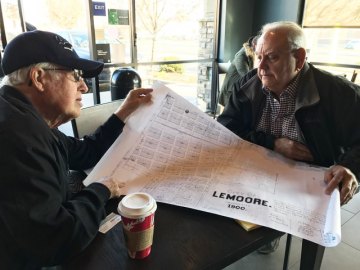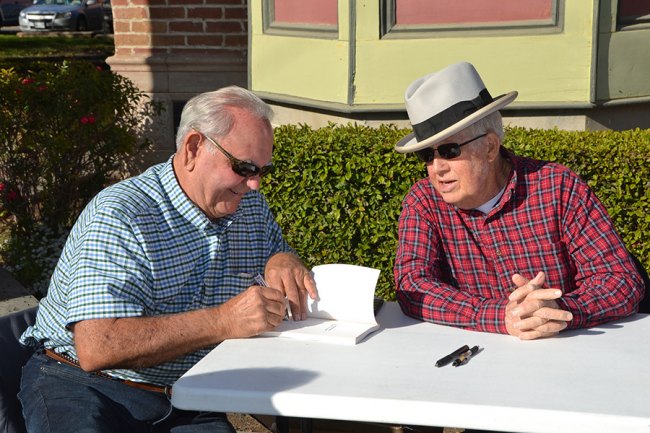Local authors publish fascinating book about Lemoore's early history and origins

In fact, there were many inaccuracies, and according to a pair of senior citizen authors, someone needed to set the record straight, so enter Lemoore authors Bill Black, 74 and Stephen Emanuels 80, who like many men their age, could be enjoying retirement and quietly collecting their pensions, but instead, they decided they were going to write a book – about Lemoore’s earliest years.
Much of the available history may not be as accurate as some believe, and on that note, the enterprising pair of local amateur historians, intent on discovering the facts, recently published a book that they say in fact sets the record straight.
Emanuels has long fancied himself somewhat of a local historian, and he’s a Cal Poly graduate to boot, with a degree in agricultural journalism, who in his spare time managed to create the Kings River Press and earned charter member status as one of the founders of the Lower Kings River Historical Society, both important historical tools tailored to discover Lemoore’s many historical mysteries.
Emanuels recently joined forces with former Lemoore High School Superintendent Bill Black, himself a local history “junkie” and a part-time history sleuth. The two recently published their book, a minor treatise investigating Lemoore’s early years – when Lemoore’s first settlers first migrated to the township that would eventually be named Lemoore.
The book, “A Lonesome Place to Live,” covers the years 1858 to 1878 and is currently on sale at the Lemoore Chamber of Commerce and the Sarah Mooney Museum. The book can be purchased for $20. All proceeds go to benefit the museum.
“I’ve been collecting information, bits and pieces over the years with no intention of writing a book,” said Emanuels, a 30-year resident of Lemoore and a native of Walnut Creek. “I thought that, well, this is interesting history here in Lemoore. I think I’ll just get all this stuff together and try to correct some of the published facts that I think anybody could see, were probably incorrect.”
Emanuels, who in his spare time plays the “fiddle,” a countryfied version of the violin, said he was simply interested in writing something interesting about Lemoore and then perhaps just “putting it in the library.” And that’s where he says Black came along, one day after knocking on his door seeking historical information for something he was investigating. Black was invited in and the two history buffs talked, and before long a unique partnership was born between two like-minded individuals with history on the mind. “Actually, it was Bill I think that talked us both into writing a book about it (Lemoore).”
Black, like Emanuels, is a Cal Poly grad with a degree in business, who later earned a teaching credential at Fresno State and enter the world of education, beginning with a teaching stint in Santa Barbara, and then in 1973 migrating to Lemoore where he got a job as an administrator. In 1990 Black was named the district superintendent and served until his retirement in 2003.
Between sips of Starbucks coffee and oatmeal on a recent Monday, Black recalled the origins of their collaboration. “Shortly after Steve and I met (about a story Black was doing on one of the founders of Lemoore) regarding John Heinlen, Steve shared some of the research he had done on early Lemoore and that kind of hooked me in,” recalled Black. “Well, I thought that would really tie in to what I’m doing. I was doing stories and Steve was doing a total history of early Lemoore, how it was developed and formed, and who took part in that.”
While neither suggests their historical volume will win a Pulitzer, it’s easy and interesting reading. Their mini-opus to Lemoore enlightens the reader with a more accurate telling of the facts, and sheds an important light on Lemoore’s once vague early history. It’s also based on years of extensive research. The duo has scanned far and wide seeking information about Lemoore’s founders and how Lemoore came to be.
The pair traveled extensively in their quest to understand the origins of Lemoore. They spent untold hours studying documents from the California State Archives, traveled to the nation’s National Archives in Washington D.C. where Black and Emanuels spent considerable time in the hallowed building seeking Lemoore information. They also found information in the U.C. Berkeley Bancroft Library as well as other well-known libraries. They studied and copied documents from the Bureau of Land Management, the Internet, and numerous county agencies and libraries.
Black has already published stories of his own in local outlets, including well-researched articles on the only Lemoore law enforcement officer (Oscar Beaver), to die in the line of duty in an 1892 incident, as well as an engrossing tale of the murder of Lemuel Metts, a 43-year-old Lemoore businessman murdered in Lemoore by Isaac Daily, a customer and local resident upset over a 25-cent charge for a bicycle repair. Daily shot and killed Metts apparently over the charge. Daily, the first man sentenced to death in Kings County, was executed at San Quentin in 1902.
The book also has a chapter on the true story of the naming of Lemoore. Dr. Benjamin Hamlin, according to post office records obtained by Black, was seeking to establish a new post office for what would become Lemoore. He originally requested “Lakeview,” but the assistant postmaster general in Washington D.C., a James W. Marshall, rejected the name because a “Lakeview” already existed in Sonoma County.
Read the chapter: A Paper Trail Reveals How Lemoore Was Named
Hamlin was asked to submit a new name, so he submitted Lemoore, derived from the name of Dr. Loverne Lee Moore, a local resident and one of four Indiana men to migrate to the Central Valley seeking a new life. The others include well-known names Dr. Benjamin Hamlin, Joel A. Fox, and Granville Weston Follett. You’ll have to read the book, or sit down with authors Black and Emanuels over a cup of coffee at Starbucks, to learn more about these early founders.
Somehow, despite federal regulations against using proper names for post offices, somehow it got through and the little township in the Central Valley by Tulare Lake, got its name.
The authors did discover some interesting information about Lemoore’s namesake, Moore, whose last name was stitched together to create the city’s moniker. He is often cited as a doctor, yet the authors say that while Moore may have had considerable medical knowledge, most likely under the “tutelage” of his brother, Dr. John Harrison Moore, he never earned a medical degree but may have been awarded an honorary one. Apparently, the authors note, a degree in medicine wasn’t all that important in the 19th Century.
He was however a bright fellow, having taught school at the age of 17 and then studying law and becoming a Justice of the Peace. The Ohio-born Moore and his brother later formed a partnership in a drug store in Angola, Indiana. IN 1845 he married Ellen Ralston, and at some point, Moore and his fellow Indianans, Hamlin, Fox, and Follett all ended up in Lemoore by 1874, creating the foundations for Lemoore’s future.
Black enjoyed the search for Lemoore’s origins, and what he and Emanuels discovered on their journey helped them both understand the city in which they live. “It really provided us with an understanding of how Lemoore grew into the community, how it is today, and how the surrounding landscape changed to adapt to settlers that were coming into the area,” said Black.
Writing a book isn’t easy; just ask Emanuels. “The most difficult part, I guess is trying to create a timeline that made sense,” he said. “One is apt to jump from subject to subject if you’re doing a strict timeline so what comes out is a little bit disjointed and that’s been difficult to make a smooth transition from one subject to another.”
When Black came into the picture, he helped Emanuels to refine those transitions, resulting in a better read, and the rest is history – Lemoore’s history of course. Perhaps now the two can go to work on a biography of the editor of The Leader. Now that’s an interesting story, and it could very well fill a postcard.
Lemoore
- West Hills College Thanksgiving food distribution held Nov. 15
- Lemoore High School celebrates Homecoming night with annual selection of King and Queen
- Tachi Hotel Resort Casino hosts 21st Annual Santa Rosa Rancheria Pow Wow
- NAS Lemoore squadrons return home after a long seven-month deployment
- Naval Air Station Lemoore crowd welcomed Lt. Dan Band and Gary Sinise
- Concerned Island District citizens gather Wednesday to hear Kings River updates
_0.jpg)

.jpg)





